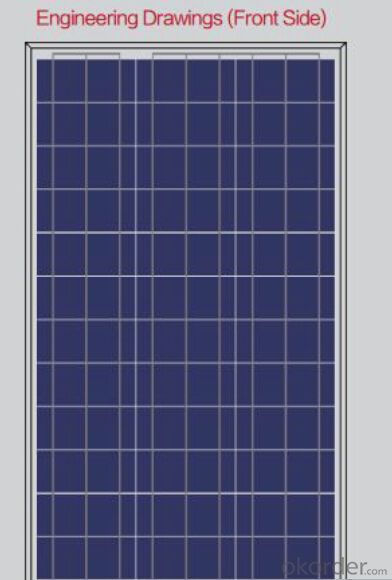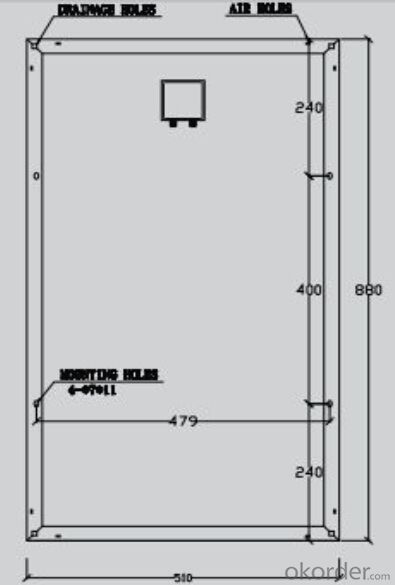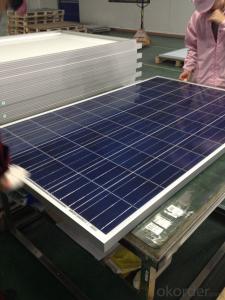Polycrystalline Solar Panels-55W-Apply to Small Solar System
- Loading Port:
- Shanghai
- Payment Terms:
- TT OR LC
- Min Order Qty:
- 10000 watt
- Supply Capability:
- 50000000 watt/month
OKorder Service Pledge
OKorder Financial Service
You Might Also Like
Product Description
Solar Polycrystalline Series Panels
Introduction of Polycrystalline Solar Panels
CNBM Solar photovoltaic (PV) Panel is designed for large electrical power requirements. It is the optimal choice for both on-grid and off-grid power systems. CNBM Solar panel offers high performance of power per square foot of solar array. Polycrystalline silicon(c-Si): often made using the Czochralski process. Single-crystal wafer cells tend to be expensive, and because they are cut from cylindrical ingots, do not completely cover a square solar cell module without a substantial waste of refined silicon. Hence most c-Si panels have uncovered gaps at the four corners of the cells.
Characteristics of Polycrystalline Solar Panels
I Solar Cell : High efficiency crystalline solar cell. Even if under the weak light, the solar module can produce maximum power output.
II Tempered glass (toughened glass): Anti-reflecting coating and high transmission rate glass increase the power output and mechanical strength of solar module.
III EVA and TPT: Using high quality EVA and TPT to prevent destroying and water.
IV AI frame: Without screw, corner connection. 6 holes on the frame can be installed easily.
V Junction box: Multi function junction box with water proof.
VI Long lifetime: ≥25 years; Less power decrease
VII Good performance of preventing from atrocious weather such as wind and hails.
VIII Resisting moisture and etching effectively, not effected by geology.
Standard Test Conditions of Polycrystalline Solar Panels
The opto-electrical specifications shown below are stabilized values being measured at Standard Test Conditions, Irradiance: 1000W/m2, Spectrum: AM1.5 at 25°C, The info below is subject to manufacturing tolerances. Where appropriate minutes of measurement are available and are used for the dimensioning of the installation.
Advantages of Polycrystalline Solar Panels
1.High reliability with guaranteed -3% to +5% power output tolerance, ensuring return on investment
2. High conversion efficiency based on leading innovative photovoltaic technologies
3. Withstands high wind-pressure and snow load, and extreme temperature variations
4. Attractive appearance Unique frame design, high mechanical strength, and easy Installation
Characteristics of Polycrystalline Solar Panels
Max Power Voltage Vmp (V) | 17.4V | 17.6 V |
Max Power Current Imp (A) | 3.17A | 3.41A |
Open Circuit Voltage Voc (V) | 22.4V | 22.6V |
Short Circuit Current Isc (A) | 3.38A | 3.64A |
Max Power Pm (W) | 55W | 60W |
Temperature Coefficient of Cells
NOCT | 47℃±2℃ |
Temperature Coefficients of Isc (%/℃) | 0.06 |
Temperature Coefficients of Voc (%/℃) | -0.33 |
Temperature Coefficients of Pmp (%/℃) | -0.45 |
Mechanical Data Solar Polycrystalline Series
Power | 45W/50W |
Dimension | 820×510×30mm |
Weight | 4.9 kg |
Tolerance | ±3% |
The dimension of the modules can be changed according to the demand of clients Limits.
Operating Temperature | –45 °C to +80°C |
Storage Temperature | –45 °C to +80°C |
Max System Voltage | 700V |
Guarantee Solar Polycrystalline Series Panels
Products Guarantee | 2 years free from defects in materials and workmanship |
Performance Guarantee | No less than 90% within 10yrs and no less than 80% within 25yrs |
Certificates | IEC, ISO, TUV, CE |
Dimension of Solar Polycrystalline Series Panels


FAQ
We have organized several common questions for our clients,may help you sincerely:
1. What’s price per watt?
A: It’s depends on the quantity, delivery date and payment terms of the order. We can talk further about the detail price issue. Our products is high quality with lower price level.
2. Can you tell me the parameter of your solar panels?
We have different series of cells with different power output, both from c-si to a-si. Please take our specification sheet for your reference.
3. How do you pack your products?
We have rich experience on how to pack the panels to make sure the safety on shipment when it arrives at the destination.
4. What is your warranty system?
Our product performance guarantees for 25 years
• 12 years guarantee for workmanship
• Timeliness of delivery
• Quality Products certified (TÜV, UL, CE, ISO)
5. How do you pack your products?
We have rich experience on how to pack the panels to make sure the safety on shipment when it arrives at the destination.
- Q:are solar panels just a photodiode?A Photodiode converts light into either current or voltage? Right?
- Yes, so are camera sensors. Except in cameras they're specially desgined to reduce noise.
- Q:Can solar panels be used for powering water treatment plants?
- Yes, solar panels can be used for powering water treatment plants. Solar energy can be harnessed to generate electricity, which can then be used to power the various processes and equipment involved in water treatment plants. This environmentally-friendly approach helps reduce reliance on fossil fuels and contributes to sustainable water management practices.
- Q:What does it take to install the solar panel? Cable wires to power source or fuse box? Anything else?How does the cable wires stay on the solar panel?
- How does the cable wires stay on the solar panel? With wire retention clips (4 per module) that are used to wrap the wire on the underside of the module frame. The home run cables to the transition box (converts between types of wire with no electrical transformation occuring) or combiner box (joins multiple source circuits in parallel, with the positives fused for safety) are usually tied along the racking system components, and with conduit sections used as needed. Racking is another big part of the installation. Don't just make your own homemade wooden rack, as these will weather away to nothing very easily, and cause great failures. GET a professionally designed metal racking system. PV modules are EXPENSIVE. Don't let the racking system cause them to break. It also requires the inverter, if you intend it to connect to the main electric service. If using multiple inverters, you need an AC combining panelboard to join them prior to entering the main electric service. Otherwise, you need to think about how else you might be using them. If you are charging batteries, you need a charge controller.
- Q:Can solar panels be installed on a canopy or pergola?
- Yes, solar panels can be installed on a canopy or pergola. In fact, installing solar panels on these structures can provide dual benefits, offering shade and generating renewable energy simultaneously. This innovative approach allows for the efficient utilization of space and can be a great solution for homeowners or businesses looking to maximize their solar energy production while enhancing their outdoor living spaces.
- Q:Mono-crystalline or poly-crystalline solar panel?
- All solar photovoltaics drop in efficiencies with higher temperatures but it isn't the 45+ C you have to worry about but rather the heat from the sunlight striking the panels. There are hybrid systems which passes water in pipes attached to the back of the solar panels to cool the panels and preheat the water for solar thermal collectors. The difference between mono-crystalline and poly-crystalline are that mono-crystalline are more efficient and more costly to make.
- Q:I mean like bread is made of wheat, what are solar panels made up of?How are they manufactured?
- Solar panels (aka photovoltaic panel) are most often made up of thin wafers of crystalline silicon or cadmium telluride. As photons from the sun enter the photovoltaic cell, electrons are freed from the substrate when are then collected by wires that run throughout the panel. And as we know electrons=electricity!
- Q:i don't know very much about it, but can you somehow take off the little solar panels off of the outdoor light things and make it so you can hook an outlet up to it and plug in to it like a phone charger for electricity.
- Little solar panels on lights are very low power. The battery in one such may be 0.5 Amp-hours and .2 V ; it may be different but it should be marked on the panel/battery/manual. An outlet in your house is designed to run on 20 V (typically in N. Am.) and they run on alternating current (AC) whereas the panel generates direct current (DC). (If you don't know the difference, do not worry to much but just understand that they are not directly compatible.) You therefore need an inverter to change DC to AC (and lose some although inverters are now very efficient). But the amount of power generated by those panels is still very small. That is why solar lights are low power (just a few watts in most cases). To make things even more irritating, phone chargers do not work off 20 V AC as you are charging the battery and need a low voltage DC -- which is what the solar panel is giving you. It is almost certain that the voltage from the panel will be less than the voltage required for the phone. The charger is mostly cable but there is a black box incorporated and it should say what the voltage and current output are (the input will be 20V). So you should be able to overcome this not by hooking up the panel to a 20V outlet and then plugging the charger in but by hooking up the panel to the phone directly if you can get enough voltage out of the solar panel (or hook up several) and if you fashion a connection device. They already make them -- solar battery chargers and I am sure you can enter that into a search engine and find loads. Typically the panel alone is much more than a solar light -- which shows the relative power requirements.
- Q:I have heard you can make your own solar panels.... But How?Where do you start? Is it cheap, or should I just BUY them already made?
- Well, I can think of a couple places, that you might have got that info from. There are several plans on the net. to build solar heaters from auxillary window units, to full thermal mass walls, with stacked 55 gallon barrels painted flat black, and filled with water. Old Mother Earth News magazines are a great source for these, but its basically sittin a closed box in the sun. . . Not very sexy, and not exactly Rocket Science, I'm thinkin what your askin about is Photovoltaics. Basically a reaction in a silicon chip, that pushes an electron toward the grid. Electiricty producing solar panels, are beyond the capabilities of a single person, however, they''re are (or were a couple months ago). a couple retail sales OKorder stores, scavaging they''re broken panels, cutting out the individual single cells, and then selling them as kits, with instructions how to wire, solder and assmeble working cells. Thats probably what your hearing about, and I think they ended up being about /2 price what they''re new ones sell for. Then you can move on to the bottlemeck problem, that all the green alternative ideas run into . . .How to store it Good luck, and Good Hunting . . Tim
- Q:How could I find out what the amp output of a solar panel? Specifically, I want to know how many milliamps can the solar panel on a Casio fx-260 put out?
- You need full sunshine from the sun, or a lamp that will give a light spectrum similar to the sun, a volt meter, Milli-amp meter, and a variable resistor of 0 to 000 ohms. The voltmeter test leads go across the solar cell leads. The amp meter leads will be in series with the solar cell. Let's say, positive lead of the solar cell to the the positive lead of the amp meter, the negative lead of the amp meter to one terminal of the variable resistor, and the wiper terminal of the variable resistor to the negative lead of the solar cell. Slowly decrease the value of the resistor until the voltage from the solar cell just begins to drop. Take note of the amp meter reading. This is about the high end range of the solar cell. You might want to begin with a micro-amp meter for the current meter.
- Q:What is the average lifespan of a solar panel?
- The average lifespan of a solar panel is typically around 25 to 30 years.
1. Manufacturer Overview |
|
|---|---|
| Location | |
| Year Established | |
| Annual Output Value | |
| Main Markets | |
| Company Certifications | |
2. Manufacturer Certificates |
|
|---|---|
| a) Certification Name | |
| Range | |
| Reference | |
| Validity Period | |
3. Manufacturer Capability |
|
|---|---|
| a)Trade Capacity | |
| Nearest Port | |
| Export Percentage | |
| No.of Employees in Trade Department | |
| Language Spoken: | |
| b)Factory Information | |
| Factory Size: | |
| No. of Production Lines | |
| Contract Manufacturing | |
| Product Price Range | |
Send your message to us
Polycrystalline Solar Panels-55W-Apply to Small Solar System
- Loading Port:
- Shanghai
- Payment Terms:
- TT OR LC
- Min Order Qty:
- 10000 watt
- Supply Capability:
- 50000000 watt/month
OKorder Service Pledge
OKorder Financial Service
Similar products
New products
Hot products
Hot Searches
Related keywords





























